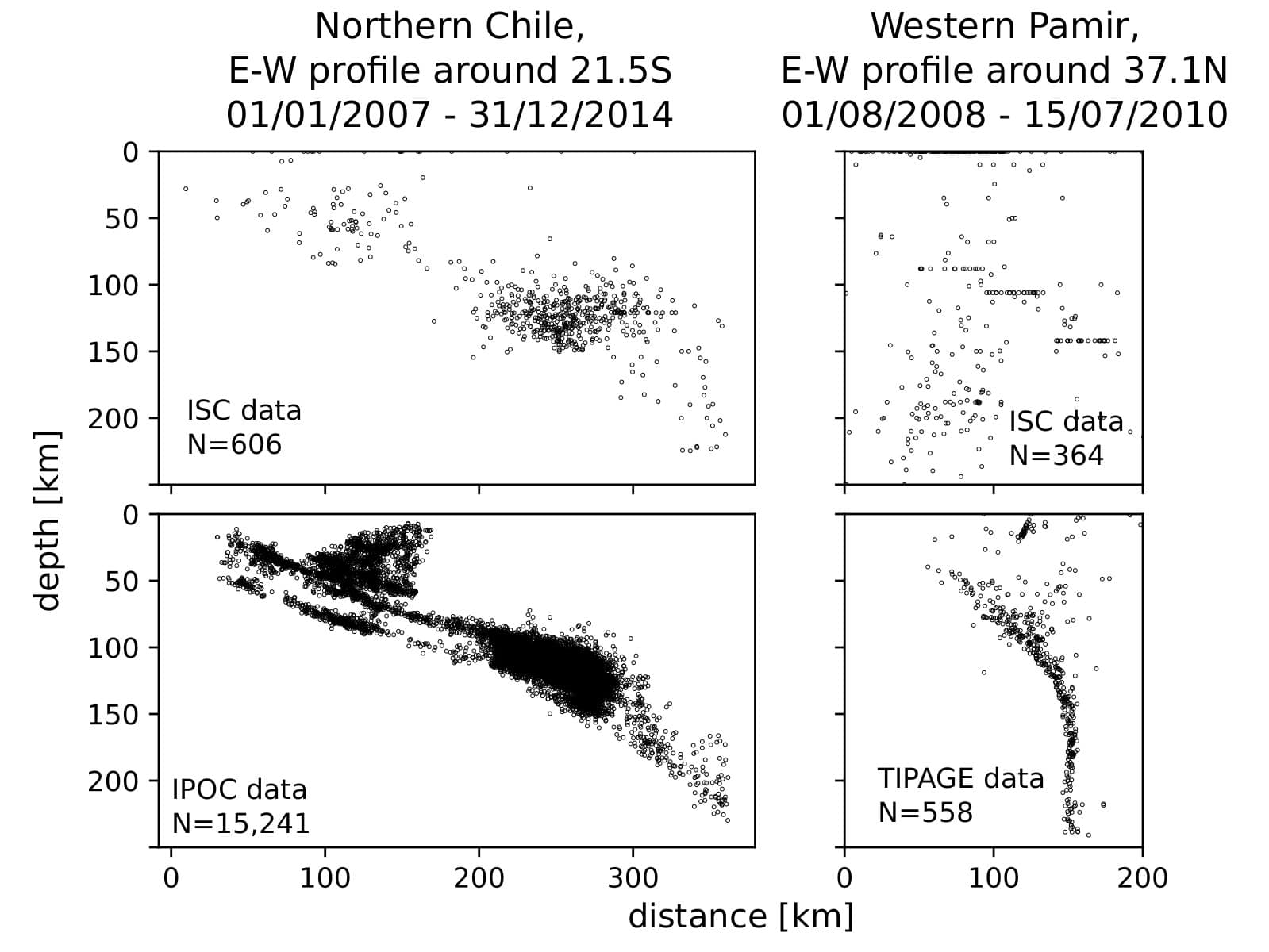Project MILESTONE (MIcroseismicity iLuminatEs SubducTion zONE processes) is an ERC Starting Grant project that is currently carried out at the Institute of Geophysics, CAS, Prague. It aims at better characterizing subduction zone megathrusts as well as the downgoing slabs of oceanic lithosphere by compiling a new generation of microseismicity catalogs that are complete to low magnitudes. To achieve this, machine learning based tools (such as the pickers available from SeisBench) are calibrated and applied. Consistent automated processing of large existing datasets will then make it possible to find spatial and temporal patterns of seismicity that differ both along-strike a single subduction zone and between different subduction zones. Based on these results, we aim to evaluate in which way parameters like downgoing plate age, convergence velocity, plate hydration or slab dip angle affect subduction zone processes.
Project Duration: 01/06/2021 to 31/05/2026

Milestone Team at IG-CAS, Prague:
- Christian Sippl (PI; contact: sippl@ig.cas.cz)
- Dominika Godova (Postdoc; WP5)
- Ignacio Castro Melgar (Postdoc, WP2)
- Nazia Hassan (PhD student WP2)
- Nooshin Najafipour (PhD student WP1)
- Jorge Puente Huerta (PhD student WP1)
External Collaborators:
- Marcos Moreno (Universidad Catolica de Chile, Santiago de Chile)
- Timm John (Free University of Berlin, Germany)
- Jonathan Bedford (Ruhr-University Bochum, Germany)
- Sebastian Hainzl (GFZ Potsdam, Germany)
Project MILESTONE is funded by the European Research Council (ERC) under the European Union’s Horizon 2020 research and innovation programme (Grant agreement No. 947856; project StG2020-947856).
Project Goals
- Test, compare and calibrate machine learning based techniques for seismic phase picking and association, integrating them into an automatized workflow of seismicity catalog generation
- Apply this workflow to three or four different subduction zone segments where data from longer-term dense deployments are available; retrieval of “deep” catalogs with low completeness magnitude
- Conduct analysis that utilizes these catalogs as input, such as local earthquake tomography, analysis of b-values or aftershock productivity
- Combination of these results with evidence from GNSS/InSAR (to characterize the plate interface) or theoretical petrology/geodynamic modeling (to characterize slab processes)
- Being able to locate and analyze along-strike and/or temporal changes inside one subduction zone segment as well as systematic differences between different segments
Project Structure
MILESTONE is composed of five work packages as follows:
-
-
- WP1: Earthquake catalog generation: building “deep” earthquake catalogs using novel machine learning based techniques
- WP2: Tomographic Inversion: using the obtained phase picks to construct highly resolved tomographic images of subduction zones
- WP3: Statistics and Imaging: statistical seismology using the “deep” catalogs, supported by receiver function analysis
- WP4: Plate Interface Processes: Combining seismicity and GNSS/InSAR constraints to try to define asperities and their properties
- WP5: Petrophysical and Thermal Models: Evaluation of intraslab processes with a combination of seismological and petrological analysis as well as modeling
-
Outputs and Publications
2023:
- Hormazabal, J., Moreno, M. Ortega-Culaciati, F., Baez, J.C., Pena, C., Sippl, C., Gonzalez-Vidal, D., Ruiz, J., Metzger, S., Yoshioka, S. (2023), Fast relocking and aftershock-seismicity evolution following the 2015 Mw 8.3 Illapel earthquake in Chile, Scientific Reports, 13, 19511., https://doi.org/10.1038/s41598-023-45369-9
- , , , , , , et al. (2023). Relation between oceanic plate structure, patterns of interplate locking and microseismicity in the 1922 Atacama seismic gap. Geophysical Research Letters, 50, e2023GL103565. https://doi.org/10.1029/2023GL103565
- Sippl, C., Schurr, B., Münchmeyer, J., Barrientos, S., Oncken, O. (2023), The Northern Chile forearc constrained by 15 years of permanent seismic monitoring, Journal of South American Earth Sciences, 126, 104326, https://doi.org/10.1016/j.jsames.2023.104326
2022:
- Sippl, C., Dielforder, A., John, T., & Schmalholz, S. M. (2022). Global constraints on intermediate-depth intraslab stresses from slab geometries and mechanisms of double seismic zone earthquakes. Geochemistry, Geophysics, Geosystems, 23, e2022GC010498. https://doi.org/10.1029/2022GC010498
- Geersen, J., Sippl, C., Harmon, N. (2022). Impact of bending-related faulting and oceanic-plate topography on slab hydration and intermediate-depth seismicity. Geosphere, 18 (2), 562–584. https://doi.org/10.1130/GES02367.1
- Morales-Yáñez, C., Bustamante, L., Benavente, R. , Sippl, C., Moreno, M. (2022), B-value variations in the Central Chile seismic gap assessed by a Bayesian transdimensional approach. Scientific Reports, 12, 21710. https://doi.org/10.1038/s41598-022-25338-4
2021:
- Sippl, C., Moreno, M., Benavente, R. (2021). Microseismicity appears to outline highly coupled regions on the Central Chile megathrust. Journal of Geophysical Research, 126, e2021JB022252. https://doi.org/10.1029/2021JB022252
Datasets
Links to Datasets (seismicity catalogs. slab geometries) produced within the framework of the project will be provided here.
Published seismicity catalogs:

Comparison between earthquake locations in Northern Chile (left column) and the Western Pamir (right column), taken from global catalogs (upper row) and retrieved with an automated procedure using locally recorded seismic data (lower row). In both cases, the same cross section for the same time period is shown for both catalogs. This illustrates that analyzing local seismic data leads to a much clearer picture due to more events and improved location precision.


